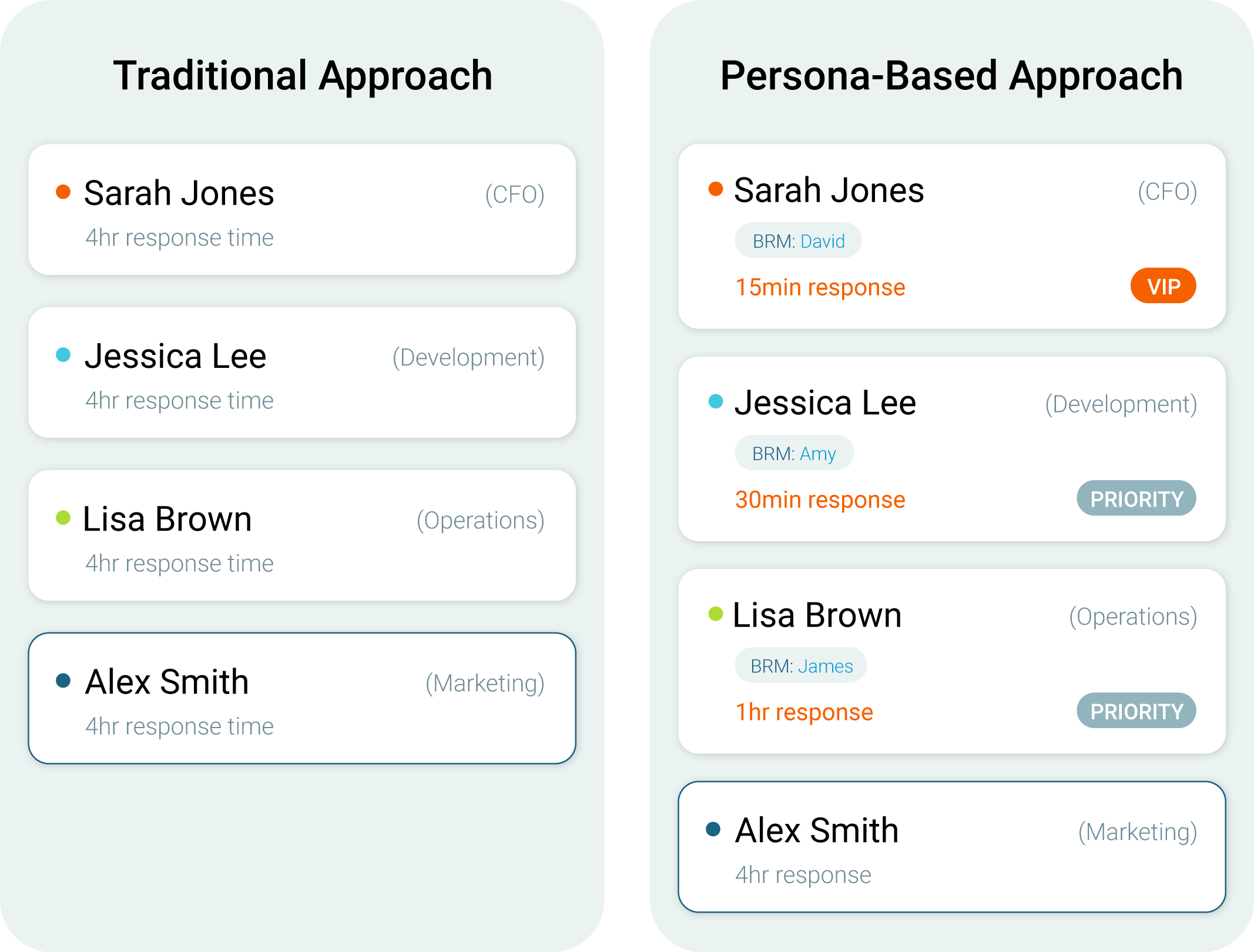A User-Centric Approach to ITSM Service Delivery
Technical compliance with service level agreement (SLA) metrics often masks real service quality issues in ITSM operations: IT teams can hit every resolution target while users remain deeply frustrated. The disconnect usually results from measuring what's achievable rather than what's meaningful. As it happens, many ITSM implementations fail because they don’t bridge the gap between prioritizing process adherence and service experience.
What if your service desk focused less on ticket resolution times and more on solving users' actual business problems? Is your ITSM practice ready for this fundamental shift? If not, how do you transform your ITSM delivery approach?
In this article, we discuss recommended practices for ITSM service delivery and how they help enhance the service value for enterprises of all sizes. We also look at hands-on approaches that follow ITIL 4's guidance on creating genuine value for people who depend on them daily.
Summary of ITSM service delivery best practices
Aspect | Best practice |
|---|---|
Emphasize customer needs over IT capabilities | Adopt practices to design services based on customer needs rather than IT capabilities. |
Design service delivery with user-centricity in mind | Map complete user journeys before implementing tools or code, ensuring that every aspect of service delivery focuses on user experience. |
Define service boundaries with an ITSM catalog | Structure your service catalog around business functions rather than technical components. |
Conduct value stream mapping for service optimization | Visualize end-to-end service journeys to identify inefficiencies and optimize handoffs between teams for improved delivery times. |
Move beyond basic SLAs to experience-based agreements | Take a more advanced approach by measuring what users actually experience rather than just using typical SLAs. |
Adopt smart measurement practices for maximum impact | Implement targeted monitoring of business-critical components rather than attempting to measure everything. |
Implement persona-based service delivery | Map stakeholder journeys and create targeted approaches for different user groups to improve service perception. |
Emphasize customer needs over IT capabilities
A service delivery practice should begin with the understanding that IT exists to enable business outcomes, not just to deliver technology. Quite frequently, organizations invest in sophisticated service management tools only to discover that their processes are designed around IT capabilities rather than customer needs.
At the heart of these problems is how IT is structured and what it can do, with the big missing piece being a clear business model for IT. A customer-centric service delivery model proposes that it is possible to establish service standards that map to existing technical capabilities yet remain flexible enough to support evolving business requirements and accommodate organizational shifts (digital transformation, remote work, business agility, cross-functional collaboration, etc.).
To help address these issues, ITIL 4's Service Value System (SVS) provides a comprehensive model for understanding how organizations can create “value” through IT services. What customers consider valuable is subjective; it depends on how they experience the service and what they initially expected. Importantly, the value a customer perceives can depend not just on what the service costs them but also on the outcomes they achieve.
Design service delivery with user-centricity in mind
The four dimensions of ITIL 4—Organizations and People, Information and Technology, Partners and Suppliers, and Value Streams and Processes—explicitly acknowledge the fact that service quality depends on both internal capabilities and external partnerships. Design your ITSM services based on ITIL4's recommendations and with a clear understanding of user journeys to understand the end-to-end experience of discovering, requesting, using, and getting support for a service.
Mapping these journeys in detail is possible even before writing a single line of code or adopting any tool. You can begin by shadowing users to understand their workflow, pain points, and what success looks like from their perspective.
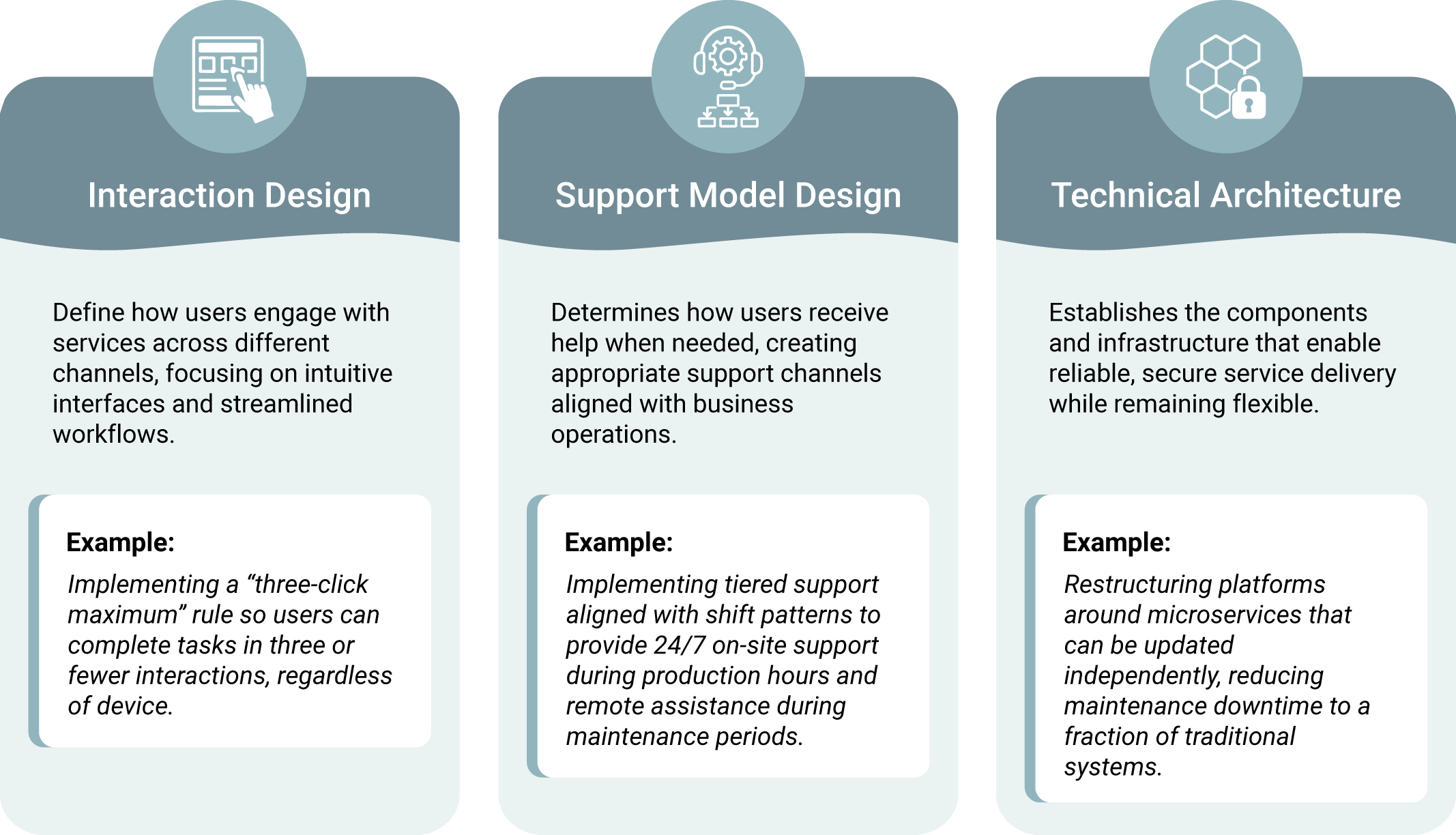
A user-centered approach extending to every aspect of service design
Define service boundaries with an ITSM catalog
The service design stage should also extend to defining clear service boundaries and dependencies. The most fundamental improvement any organization can make with its service delivery practice is to design service catalogs around business functions rather than technical components. The catalog should organize services based on what users are trying to accomplish, not how the technology works behind the scenes. The goal is to shield users from needing technical knowledge just to access the services they require.
Note that the ITIL 4 framework distinguishes between the service catalog (customer-facing services) and the service portfolio (all services, including those in development or retired). The distinction helps you control what's visible to users, manage expectations, and be sure that you're only promoting services ready for consumption. The catalog should be fundamentally structured to communicate what services are available to customers or users, how to request them, what to expect in terms of delivery, and often the associated costs or requirements. Services can be related or unrelated to ITSM. However, the larger objective of the catalog remains the same in all contexts: where expectations are to be set regarding service delivery.
From an ITSM standpoint, your service catalog should encompass:
- Service definitions: Clear descriptions of what each service does, in business-friendly language
- Request methods: How users can order or request each service
- Service levels: Expected performance metrics and response times
- Support information: Whom to contact for help and how
- Financial and value aspects: Associated costs and the business value the service offers.
- Approval workflows: What approvals are needed to request certain services
- Dependencies: How services relate to each other and to business processes
- Eligibility: Who can request which services
Conduct value stream mapping for service optimization
A practical approach to aligning IT services with what your business actually needs to accomplish can be borrowed from lean methodologies, where value stream mapping helps trace the service journey from request to fulfillment. With this approach, you can visualize the entire service delivery process to spot inefficiencies, bottlenecks, and opportunities for improvement.
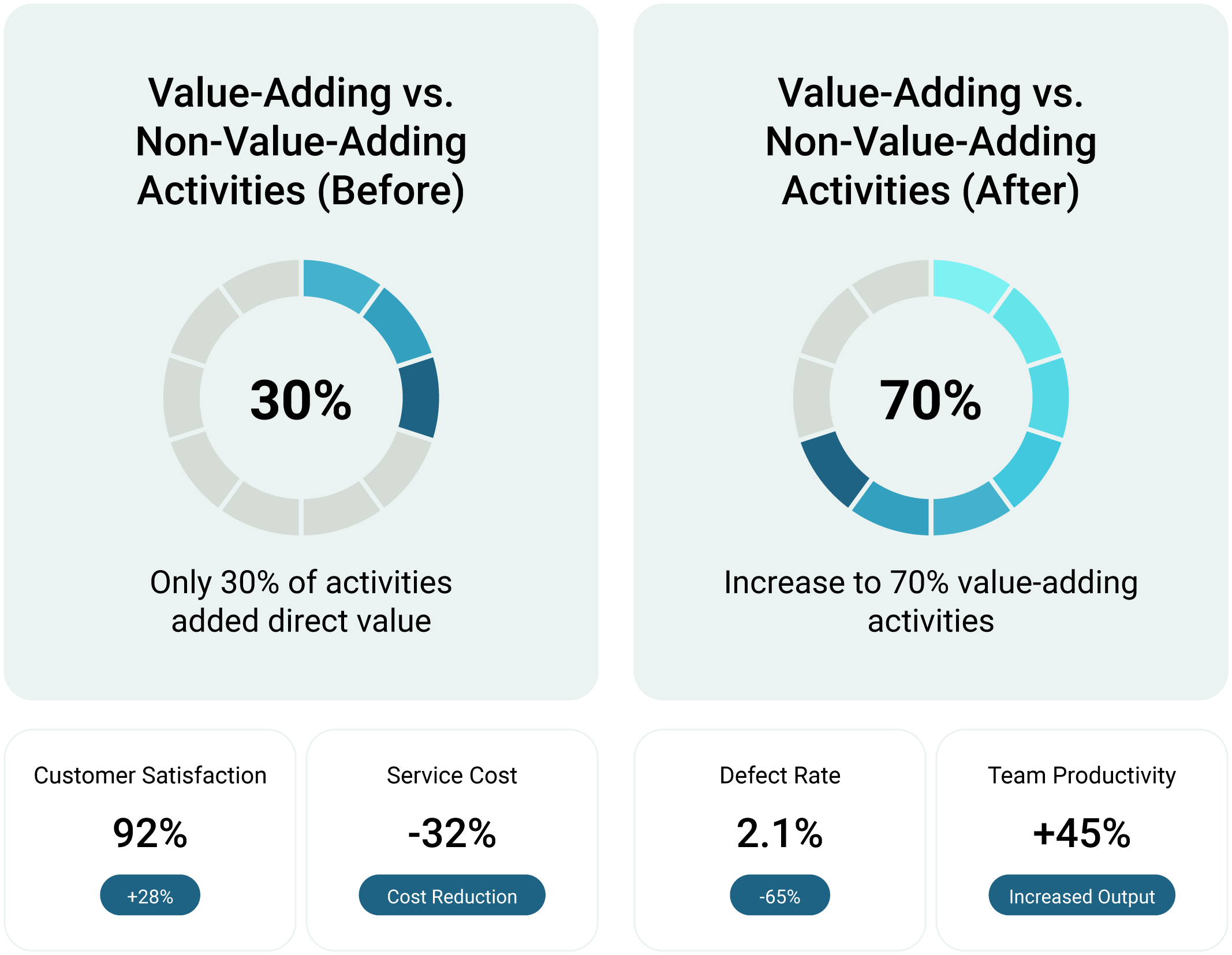
Typical insights from value stream mapping
A value mapping practice delivers its most significant impact by creating a shared understanding of the complete service journey across organizational silos. Teams discover that local optimizations sometimes create downstream problems, and seeing the entire flow reveals counterintuitive improvement opportunities. For ongoing improvement, these maps should be treated as living documents, updated as processes change, and consistently used to measure the real flow against the ideal state.
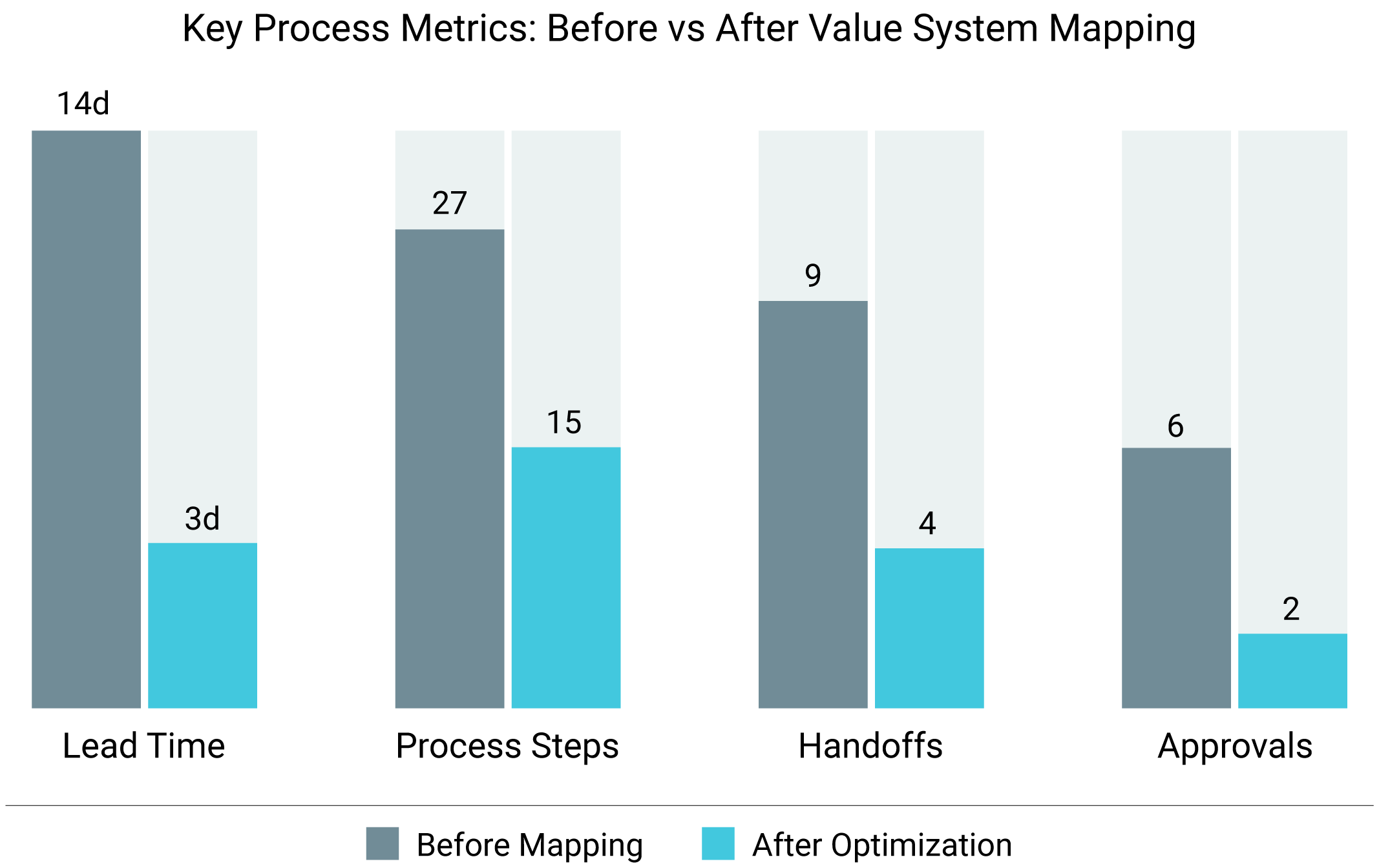
Value stream mapping impact analysis
The process of applying value stream mapping includes these steps:
- Define the beginning and end points of the service process.
- Document all activities, handoffs, waiting periods, and decision points.
- Calculate key metrics like lead times and completion percentages.
- Look for redundancies, unnecessary approvals, and bottlenecks.
- Create an optimized process that reduces waste while improving outcomes.
- Track the impact of changes on service metrics.
You can conduct value stream mapping exercises when services consistently miss target delivery times, multiple teams express frustration with handoff processes, or customers complain about complexity and delays. To ensure that the mapping process works most effectively, consider having it be facilitated by someone with lean methodology experience, but include participants from every team involved in service delivery. Critically, the sprint should include representatives who handle exceptions and escalations, as these scenarios often reveal the most significant process weaknesses.
Move beyond basic SLAs to experience-based agreements
Traditional SLAs typically revolve around metrics to provide operational guardrails, but they frequently miss the essence of service value from a user perspective. As an example, a 99.9% available service can still frustrate users if that 0.1% downtime occurs during a critical time like month-end financial closing.
Many enterprises are now moving to adopt the experience-level agreement (XLA) approach, which extends traditional SLA metrics to include experience-based measurements that better reflect service value as perceived by users. With this framework, you can measure business impact in minutes rather than just capturing technical downtime. As mentioned, the same technical issue can have dramatically different business significance depending on timing and context.
The transition to XLAs requires developing composite indices that combine both quantitative measures (already captured in ITSM tools) and qualitative measures. This includes (but is not limited to) sentiment analysis from user feedback, productivity impact assessments, and business outcome correlation metrics. When aggregated into experience scores, you achieve a more holistic view of service effectiveness.
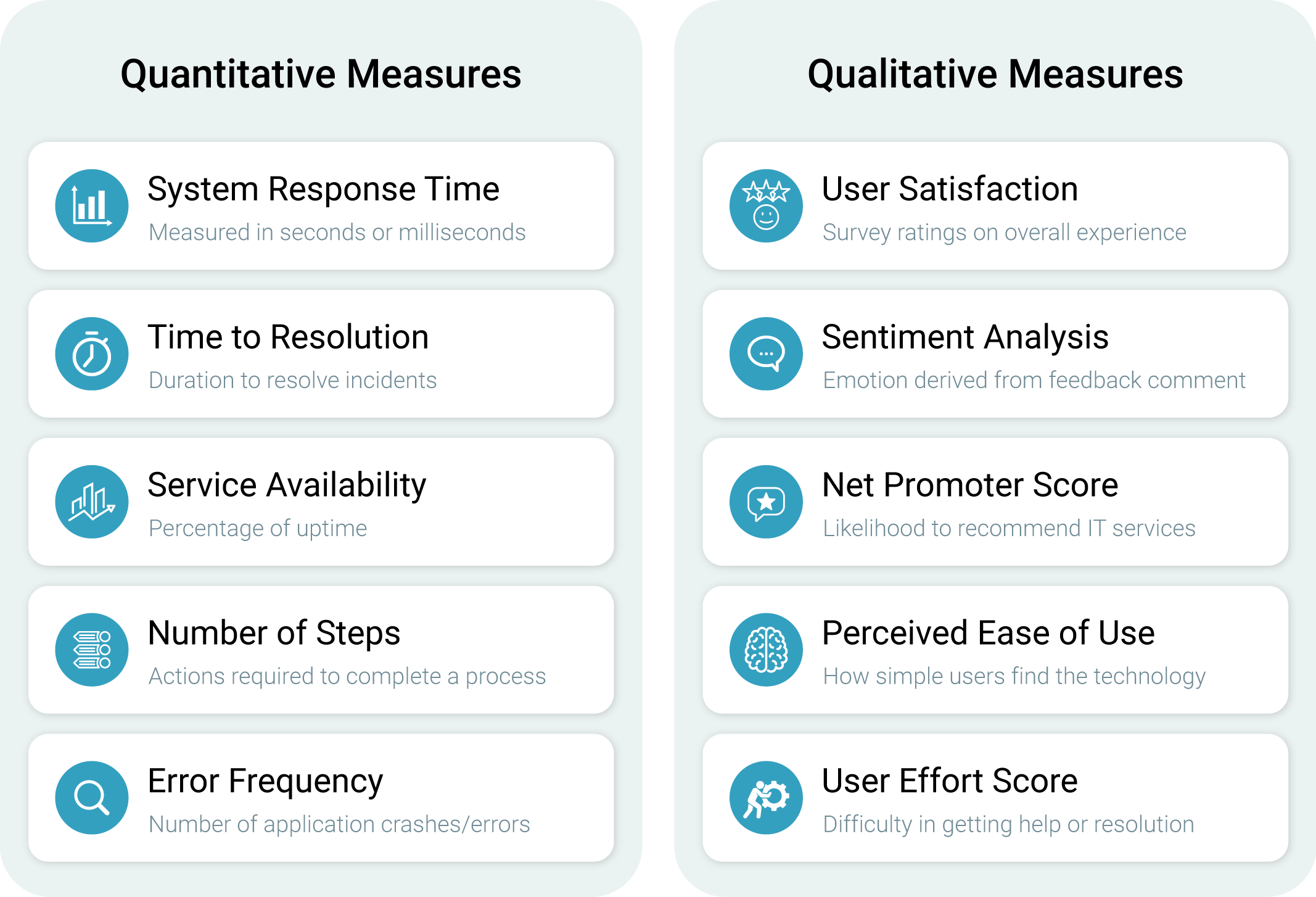
XLA measurement framework
For instance, a user digital experience score might combine quantitative elements like system performance with qualitative elements like satisfaction ratings to create a more meaningful measurement of how technology enables employees to accomplish their work effectively.
It is also important to identify what truly constitutes service success from different perspectives. Begin by identifying the “critical few” business journeys that users follow to accomplish meaningful work. For each journey, map the IT touchpoints and determine what constitutes a successful experience. Then establish baseline measurements before gradually introducing experience targets alongside traditional operational metrics.
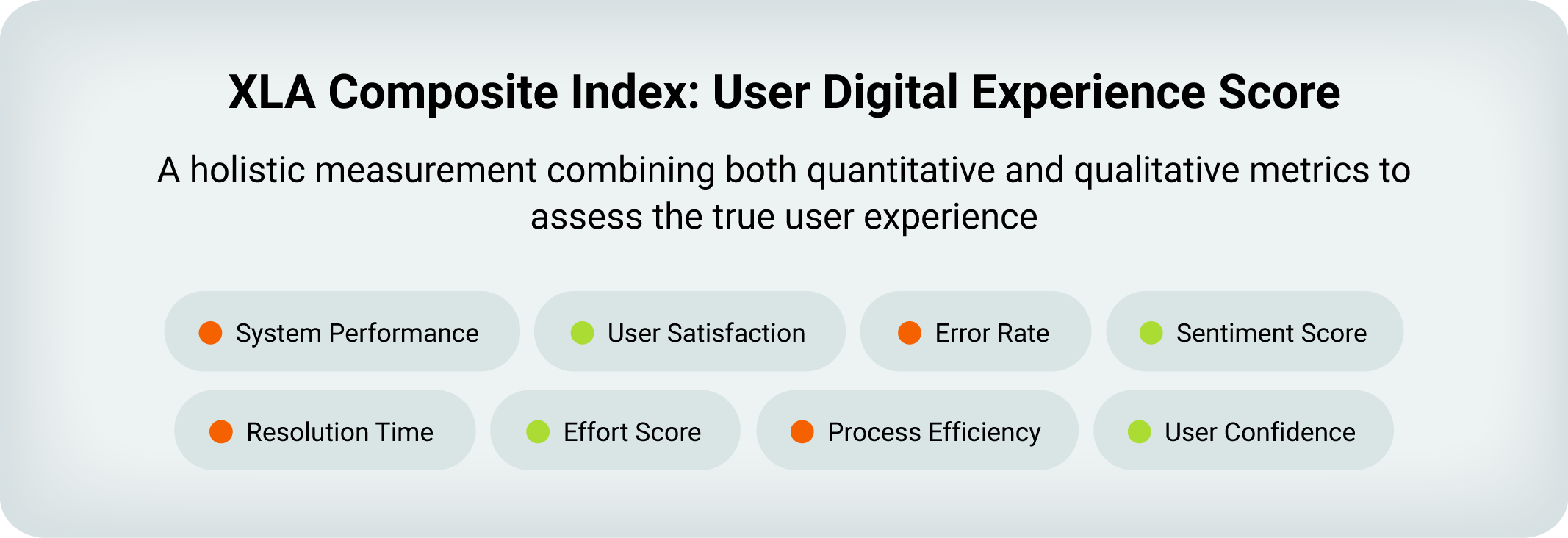
Measuring qualitative and quantitative metrics for XLA
Adopt smart measurement practices for maximum impact
Savvy IT organizations implement monitoring by focusing on business-critical components (top down) rather than attempting comprehensive measurement of all infrastructure elements (bottom up). The most successful organizations employ a tiered monitoring approach that varies in depth and frequency based on business impact.
Essentially, you connect your monitoring solution to each of the service components, and it evaluates each configuration item (CI) to produce a service health dashboard. The ultimate objective should be to achieve a service availability score with a segregated list of all the incidents that reduced performance from the established SLA target.
That said, the monitoring framework should be technically capable of capturing the most meaningful indicators of service health. In most cases, it's a balanced scorecard of service impact analysis that combines technical and experiential metrics in the dashboard. It can also be an “integrated health view” that correlates data from multiple monitoring tools to present a comprehensive picture of service performance across the value stream.
Implement persona-based service delivery
An organization that knows its user personas shouldn't waste time engaging stakeholders that don't fit the profile. Conversely, every service team should keep a list of key stakeholders they need to satisfy, also called a “VIP list” or “priority user list.” Each priority user is assigned to a business relationship manager in an enterprise service management context.
However, this doesn't mean that IT organizations without a formal business relationship management function should forgo identifying target stakeholders.
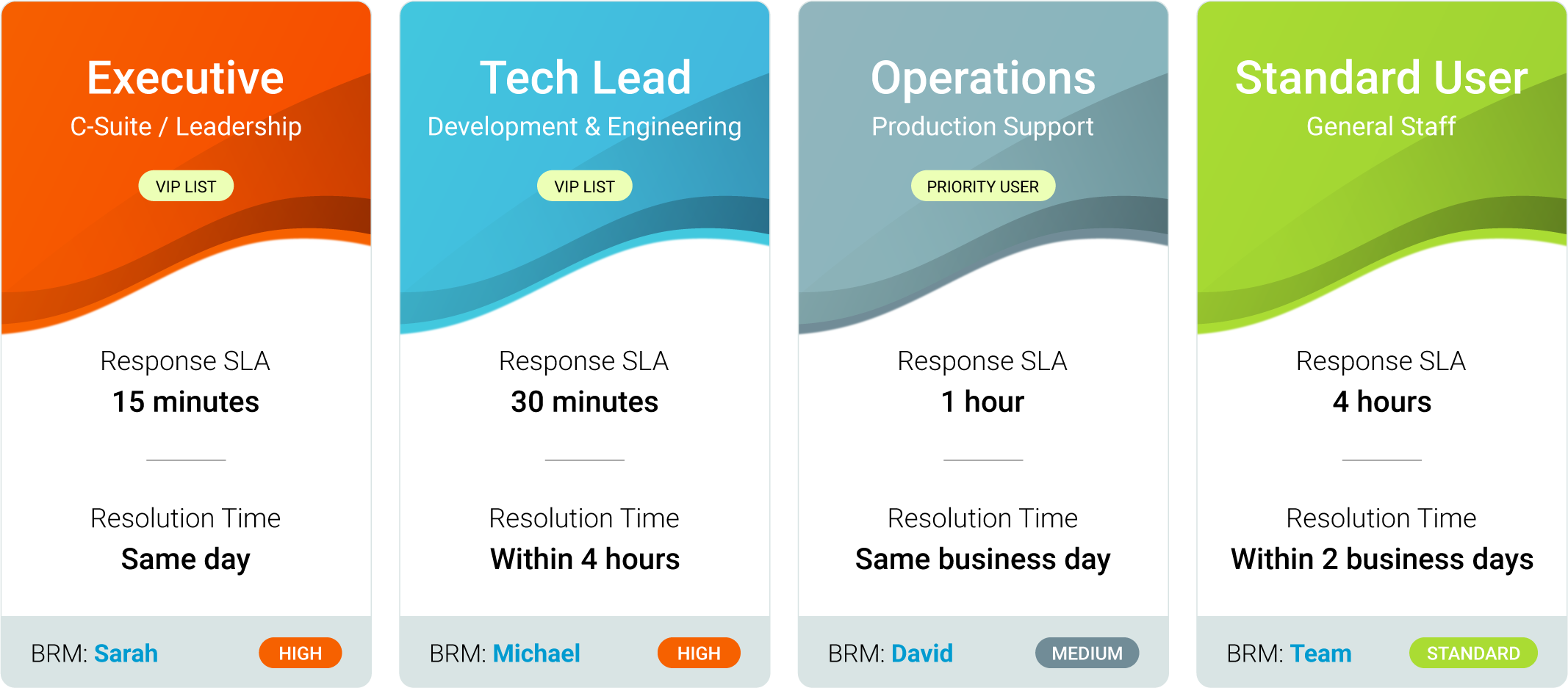
Segregating strategic and non-strategic users
Maintaining a list of strategic target users can help match service interactions with employees from key business units and flag them as having high visibility. For example, suppose you deliver services intended for the executive team. In that case, you would like to know if a senior leader from the C-suite contacted your service desk and submitted a ticket for a laptop issue.
The stakeholder map below shows individuals working for a target business unit and their likely roles in the experience perception for your ITSM service reputation.
Type | Description | Example |
|---|---|---|
Service evaluators | Primary users who directly experience ITSM service quality | Executive assistants, business analysts |
Service influencers | Stakeholders who shape perceptions about service value | Department heads, team leaders |
Resource allocators | Those who control funding for service improvements | Financial directors, budget owners |
Experience approvers | Senior leaders who ultimately judge service success | C-suite executives, board members |
For context, the person who contacted your service desk might be a departmental super user who will evaluate your ITSM service quality. That super user might love your incident resolution process and recommend your support team to their department manager. Still, your service reputation won't improve until other stakeholders agree with their assessment (influencers), the IT investment funds are allocated (resource allocators), and a senior IT leader approves the service enhancement budget (experience approver).
The recommended practice is to map the stakeholder journey for service perception in your organization and identify touchpoints for each stakeholder type. A persona-based service delivery helps you map stakeholder expectations, understand each person's preferences in the service interaction, and develop an appropriate plan for meeting their needs to ensure an excellent experience. Equally important is designing service interactions that deliberately engage all four stakeholder groups through targeted communications and relationship-building activities.
Conclusion
The purpose of ITSM service delivery is multidimensional and highly subjective. For the most part, organizations need solutions where the value of the service is seen in both affordability for the customer and the positive results it produces for them. Because value varies with individual expectations, efforts to improve ITSM service quality inevitably require organizations to move all levels of management closer to the customer and give frontline service employees the required legroom to offer the best possible technical support.
Irrespective of your organization's maturity stage, SolarWinds provides sophisticated analytics, integrated change management, and business service mapping that align IT service delivery with business objectives. Check our interactive ITSM maturity model to see where your enterprise stands and what you can do to improve your IT service delivery.
